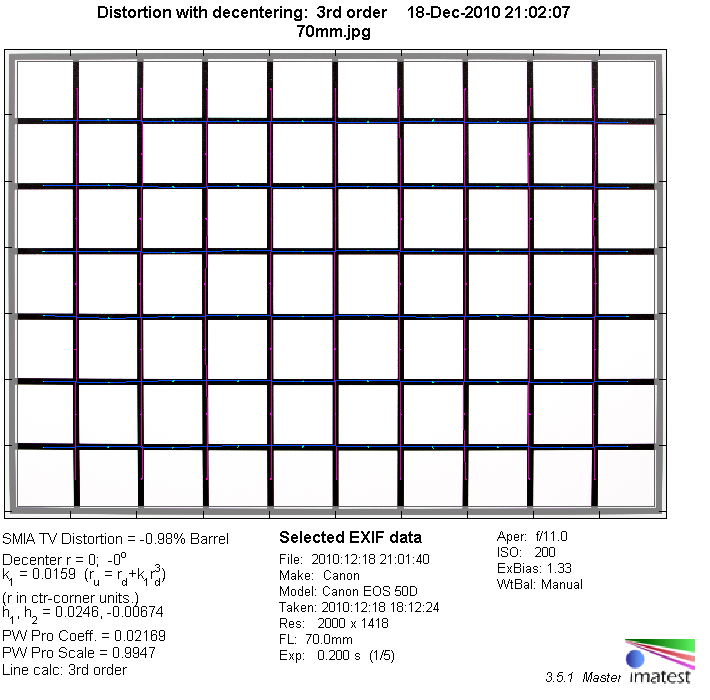|
Canon EF 70-300mm f/4-5.6 USM L IS - APS-C Format Review / Lab Test - Analysis |
|
Lens Reviews -
Canon EOS (APS-C)
|
|
Page 2 of 2

Distortion
On APS-C DSLRs the Canon EF 70-300mm L IS shows only a slight barrel distortion at 70mm and slight pincushion distortion towards the long end. This is about average for a lens in this class here.
|
Move the mouse cursor over the focal length text marks below to observe the respective distortion
|
| 70mm |
200mm |
300mm |

|
Vignetting
Light falloff is negligible when using the EF 70-300mm USM L IS on an APS-C DSLR even at max. aperture.

MTF (resolution)
The lens showed pretty good resolution figures during our full format test and it gets, of course, better on an APS-C format camera due to the sweet spot effect here. The lens performs best at 70mm but it can keep a very good to excellent quality throughout the zoom range. There's only a slight drop towards longer focal lengths - primarily in the image center. There's only a slight amount of field curvature. The tested sample was very well centered for an IS lens.
Please note that the MTF results are not directly comparable across the different systems!
Below is a simplified summary of the formal findings. The chart shows line widths per picture height (LW/PH) which can be taken as a measure for sharpness.
If you want to know more about the MTF50 figures you may check out the corresponding Imatest Explanations
Chromatic Aberrations
The lens produced a varying but low degree of chromatic aberrations (color shadows at harsh contrast transitions) at the image borders. The average CA pixel width remains well below 1 pixel throughout the range and it's especially low at 200mm. Such low CAs contribute to a high subjective sharpness perception.

Bokeh
Normally we don't really analyze the bokeh of "slow" speed lenses but we're making an exception to the rule here because of the high end nature of the Canon 70-300mm L IS.
The out-of-focus blur in the critical focus transition zone is smooth in the background. The foreground blur is still very good albeit slightly more nervous.
Out-of-focus highlights are perfectly rendered near the image center. The discs have a circular shape with no outlining and a smooth inner portion. On APS-C format it avoids the "cat's eyes" near the image borders/corners - another nice side effect of the sweet spot effect.
 Note: the samples have been taken from our full format test. The bokeh remains the same except for the highlight analysis (taken from the cropped portion).
Note: the samples have been taken from our full format test. The bokeh remains the same except for the highlight analysis (taken from the cropped portion).
Bokeh Fringing / Longitudinal Chromatic Aberrations (LoCA)
Bokeh fringing (LoCAs) are generally no topic on a slow speed lens. There're neither green nor magenta halos in the out-of-focus
zones - see the following image portion taken at 200mm f/5.
 Note: the samples have been taken from our full format test. The bokeh fringing remains the same, of course.
Note: the samples have been taken from our full format test. The bokeh fringing remains the same, of course.
VerdictThe Canon EF 70-300mm f/4-5.6 USM L IS shines when used on an APS-C DSLR. It is capable of delivering very high
quality results throughout the entire zoom range and across the whole image field here. Distortions, lateral CAs
and vignetting are negligible. The bokeh is generally smooth and out-of-focus highlights are rendered perfectly on the
cropped format.
The build quality is outstanding and that's despite the zoom extension system - it doesn't really get any better
in this class - and the sealing is the cream on the cappuccino here. The USM AF is extremely fast and near silent.
The lens performs somewhat worse on a full format camera but we didn't find any significant downside within the
APS-C scope ... apart from its very high pricing maybe. Therefore highly recommended here!
|